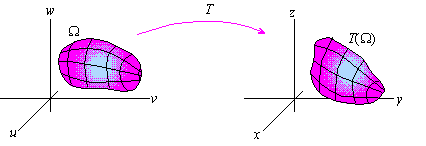Cylindrical Coordinates
A 3-dimensional coordinate transformation is a mapping of the form
|
T( u,v,w) =
á x(u,v,w), y(u,v,w), z(u,v,w)
ñ |
|
Correspondingly, a 3-dimensional coordinate transformation T maps a solid W
in the uvw-coordinate system to a solid T(W) in the xyz
-coordinate system (and similarly, T maps curves in uvw to curves in xyz, surfaces in
uvw to surfaces in xyz, and so on).
In this section, we introduce and explore two of the more important 3-dimensional
coordinate transformations.
To begin with, the cylindrical coordinates of a point P are
cartesian coordinates in which the x and y coordinates have been
transformed into polar coordinates (and the z-coordinate is left as is).
Not surprisingly, to convert to cylindrical coordinates, we simply apply x = r
cos(q) and y = r sin(q) to the x and y coordinates. That is, the cylindrical coordinate transformation
is
|
T( r,q,z) =
á r cos(q) ,r sin(q) ,z
ñ |
|
Cylindrical coordinates get their name from the fact that the surface ''r
= constant'' is a cylinder. For example, the cylinder
|
r( q, z) =
á cos( q),sin( q) ,z
ñ |
|
is obtained by setting r = 1 in the cylindrical coordinate transformation.
Likewise, parameterizations of many other level surfaces can be derived from
the cylindrical coordinate transformation.
EXAMPLE 1 Find a parametrization of the right circular cone
by pulling back into cylindrical coordinates.
Solution: Transforming x and y into polar coordinates yields
Letting z = r in the cylindrical coordinate transformation yields
|
r( r,q) =
á rcos( q),rsin( q) ,r
ñ |
|
which is a parametrization of the right circular cone.
EXAMPLE 2 Parameterize the surface z = x2-y2 by pulling
back into cylindrical coordinates
Solution: Setting x = rcos(q) and y = rsin(q) leads to
|
z = r2cos2( q) -r2sin2( q) = r2cos( 2q) |
|
Thus, the parametrization is
|
r( r,q) =
á rcos( q),rsin( q) ,r2cos( 2q)
ñ |
|
Check your Reading: In what plane are the cylindrical coordinates of a point the same as its polar coordinates?
